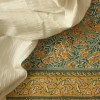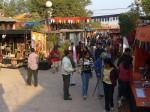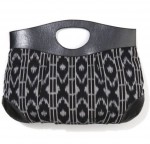Maintaining Indian Crafts

Over the past month that I have spent in India, my senses have been bombarded with smells, sounds and colours. The women on the streets wear fabulous saris, and in the classrooms my teachers wear beautiful salwar kameez of the colours of the rainbow. Going to the markets is a celebration of colour wherever you go – be it in Janpath where you find H&M and River Island factory rejects or the hippie central of Pahar Ganj, but by far the best place that I have been was Dilli Haat.
 Dilli Haat is an enclosed market where each stall acts as an ambassador for a certain craft or food from across the Indian states. Here you can really get a feel for the multitude of techniques and crafts that have developed in India over thousands of years. On my visit last week I spent all the money I had taken with me on some beautiful things. I found a natural silk scarf that was hand painted with intricate motifs of birds and fish traditional to Bihar. I also stopped by the many Rajasthani stalls filled with hand block printed goods and left with a beautiful flower printed sheet. As the sunlight was fading, I managed to find the one item that I actually needed – a thick bed cover that I use as a duvet in this heat. It’s a great quality handloom weave from Chentex in Chennimalai.
Dilli Haat is an enclosed market where each stall acts as an ambassador for a certain craft or food from across the Indian states. Here you can really get a feel for the multitude of techniques and crafts that have developed in India over thousands of years. On my visit last week I spent all the money I had taken with me on some beautiful things. I found a natural silk scarf that was hand painted with intricate motifs of birds and fish traditional to Bihar. I also stopped by the many Rajasthani stalls filled with hand block printed goods and left with a beautiful flower printed sheet. As the sunlight was fading, I managed to find the one item that I actually needed – a thick bed cover that I use as a duvet in this heat. It’s a great quality handloom weave from Chentex in Chennimalai.
My ‘manufacturing’ teacher has helped me to understand the traditional crafts and on Thursday I have a presentation on the many different local embellishments such as embroidery, printing and weaving techniques. These traditional skills are slowly dying out as shopping malls become more popular. My teacher asked me why I thought this was happening and I think it’s because shops such as Zara and Forever21 have new styles every week, while although in Dilli Haat there is an incredible choice of thousands of items, they have the same silhouettes or themes since the early days of the Mughal empire, it’s very traditional.
 I think these incredible techniques should be promoted to fashion buyers so they can work with the crafts people to accommodate ‘Western’ tastes and trends. Ikat is one of the best surprises to me so far; the technique involves tie-dyeing the yarns before weaving them into the fabric. The most intricate works are like paintings, while the simpler ones are beautiful weaves and the ethnic patterns would sit extremely well with current trends as the Inca inspiration can be seen everywhere.
I think these incredible techniques should be promoted to fashion buyers so they can work with the crafts people to accommodate ‘Western’ tastes and trends. Ikat is one of the best surprises to me so far; the technique involves tie-dyeing the yarns before weaving them into the fabric. The most intricate works are like paintings, while the simpler ones are beautiful weaves and the ethnic patterns would sit extremely well with current trends as the Inca inspiration can be seen everywhere.
 There are many organizations and companies working to make these crafts profitable and exportable. While most domestic shops are filled with polyester saris, there is reason to believe that exporting handloom textiles for home furnishings and using the traditional embellishments at fair trade prices can empower rural communities. Fabindia is a very interesting company that has the feel of a British ‘lifestyle’ shop. However, it was founded on Gandhi’s idea that Indians should buy Indian khadi (handloom cotton textiles) and nowadays it is run as any modern shop, without the haggling of the street markets and with the benefit of air-conditioning! Fabindia has helped to establish 17 community operated corporations (COCs) owned partly by the craftsmen themselves who receive a better price and guaranteed regular orders. Interestingly Fabindia is not a member of any ethical fashion association (such as the WFTO) and fair trade has a low profile on their marketing materials. I have yet to learn more about the company but these could be factors contributing towards their low profile with foreigners I’ve met in India.
There are many organizations and companies working to make these crafts profitable and exportable. While most domestic shops are filled with polyester saris, there is reason to believe that exporting handloom textiles for home furnishings and using the traditional embellishments at fair trade prices can empower rural communities. Fabindia is a very interesting company that has the feel of a British ‘lifestyle’ shop. However, it was founded on Gandhi’s idea that Indians should buy Indian khadi (handloom cotton textiles) and nowadays it is run as any modern shop, without the haggling of the street markets and with the benefit of air-conditioning! Fabindia has helped to establish 17 community operated corporations (COCs) owned partly by the craftsmen themselves who receive a better price and guaranteed regular orders. Interestingly Fabindia is not a member of any ethical fashion association (such as the WFTO) and fair trade has a low profile on their marketing materials. I have yet to learn more about the company but these could be factors contributing towards their low profile with foreigners I’ve met in India.
If you want to learn more about Indian crafts, check out AIACA (All India Artisans and Craftworkers Welfare Organisation) and Shared Talents India (a Centre for Sustainable Fashion project) which both have vast resources regarding the different techniques and contacts so that you can source from the skilled craftsmen. Dastkar is a member of AIACA and organises a few markets every year throughout India. If you are visiting India, check whether you are lucky enough to be near one of these events; I wish I were in Bangalore where their next market takes place.
Marie Vahl
http://www.chentex.org/organization.htm
http://www.rangsutra.com/index.html
http://www.aiacaonline.org/index.asp
http://www.sharedtalentindia.com/
http://www.dastkar.org/organisationalmap.htm
Women
A wide selection of stylish fashion clothing for all occasions including: dresses, tops, knitwear, skirts, eveningwear, coats, suits, jackets and more. Styles to suit a variety of tastes from classic to vintage and more in between: recycled and upcycled. This is sustainable ethical fashion at it's best.
Women's Ethical ClothingMen
If you're looking for something eco or ethical to wear for dress down friday, a casual weekend or holiday, you'll find it here. Tops, t-shirts, jeans, trousers from mainly fairtrade and organic cotton.
Men's Ethical FashionKids
Green fashion for kids is fun and made mainly from natural fibres including organic cotton and Fairtrade cotton. From baby to early teens, there's something to make all kids happy. Bright colours, animals, fun shapes that children can wear all year round.
Kids Green ClothingAccessories
A treasure trove of accessories from around the world can be found here. A vast selection of jewellery including necklaces, bracelets, rings and earrings to shoes, hats, bags, handbags and scarves. Whatever your style, these items will complete any outfit.
Eco-Friendly Accessories





Comments are closed.